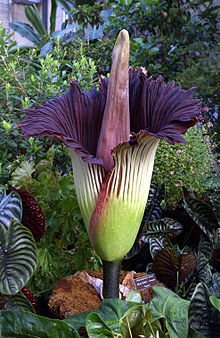Amorphophallus

Amorphophallus (from Ancient Greek amorphos, “without form, misshapen” + phallos, “penis”, referring to the shape of the prominent spadix) is a large genus of some 200 tropical and subtropical tuberous herbaceous plants from the Arum family (Araceae), native to Asia, Africa, Australia and various oceanic islands.[1][2] A few species are edible as “famine foods” after careful preparation to remove irritating chemicals.[3] The genus includes the Titan arum (A. titanum) of Indonesia, which has the largest inflorescence of any plant in the genus, and is also known as the ‘corpse flower’ for the pungent odour it produces during its flowering period, which can take up to seven years of growth before it occurs.[4]
These small to massive plants grow from a subterranean tuber. Amorphophallus tubers vary greatly from species to species, from the quite uniformly globose tuber of A. konjac to the elongated tubers of A. longituberosus and A. macrorhizus to the bizarre clustered rootstock of A. coaetaneus. From the top of this tuber a single leaf, which can be several metres across in larger species, is produced atop a trunk-like petiole followed, on maturity, by a single inflorescence. This leaf consists of a vertical leaf stalk and a horizontal blade, which may consist of a number of small leaflets. The leaf lasts one growing season. The peduncle (the primary flower stalk) can be long or short.
As is typical of the Arum family, these species develop an inflorescence consisting of an elongate or ovate spathe (a sheathing bract) which usually envelops the spadix (a flower spike with a fleshy axis). The spathe can have different colors, but mostly brownish-purple or whitish-green. On the inside, they contain ridges or warts, functioning as insect traps.
The plants are monoecious. The spadix has tiny flowers: female flowers, no more than a pistil, at the bottom, then male flowers, actually a group of stamens, and then a blank sterile area. This last part, called ‘the appendix’, consists of sterile flowers, called staminodes, and can be especially large. There is no corolla.
Once the spathe opens, pollination must happen the same day. In many species, the inflorescence emits a scent of decaying flesh in order to attract insects, though a number of species give off a pleasant odor. Through a number of ingenious insect traps, pollinating insects are kept inside the spathe to deposit pollen on the female flowers, which stay receptive for only one day, while the male flowers are still closed. These open the next day, but by then the female flowers are no longer receptive and so self-pollination is avoided. The male flowers shower the trapped insects with pollen. Once the insects escape, they can then pollinate another flower. Amorphophallus species are used as food plants by the larvae of some Lepidoptera (butterfly and moth) species including Palpifer sexnotatus and Palpifer sordida.
The pollinated flowers then develop a globose berry as a fruit. These can be red, orange-red, white, white and yellow, or blue.
